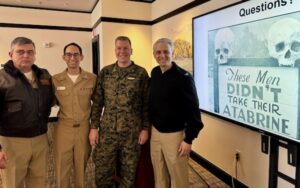
U.S. Naval Hospital Okinawa
From left to right: LCDR Vlad Stanila, LCDR Adrian Aceves, LCDR Alfred Smith, and CAPT Todd Gleason
Story by Isaac Savitz
U.S. Naval Hospital Okinawa
Okinawa, Japan: This week on Camp Foster, medical personnel from all over the island gathered together in a large audience to attend a two-day refresher course on Military Tropical Medicine (MTM). LCDR Vlad Stanila from U.S. Naval Hospital Okinawa (USNO), Preventive Medicine Specialist, coordinated the course, and USNO’s Commanding Officer CAPT Kathleen Cooperman stopped by to kick it off and welcome everyone attending. CAPT Todd Gleason, and LCDR Adrian Aceves, the presenting guests from Walter Reed National Military Medical Center (WRNMMC), with the support of LCDR Alfred Smith, 3rd Medical Battalion and CDR Catherine Berjohn, 14th Marine Regiment, Infectious Disease Specialists, instructed the course. They lectured the medical staff in attendance on ways to identify, prevent, and treat many of the viruses and diseases our service members encounter as we operate throughout the world. Navy personnel continue to serve and play a role in global engagements, from humanitarian disaster relief, bilateral training with allied forces, or contingency operations on the ground, in the air, or at sea.
Navy Medicine supports the force’s lethality by maintaining state-of-the-art medical and operational readiness. One way they do it is with the Military Tropical Medicine (MTM) course. “This course emphasizes some of the most debilitating and dangerous diseases that have had a global impact affecting the development of human civilization throughout history. Many of these morbidities are far too common afflictions in impoverished nations whose poor populations are caught up in a never-ending cycle of disease that is often coupled with malnutrition. Currently, over 1.5 billion people live below the World Bank poverty level (<$1.25 U.S. Dollars per day).” Understanding And Preventing Diseases Of Poverty In Military Tropical Medicine, by CPO Emilio Velez
CAPT Gleason said he hopes his instruction will help these caregivers identify life-threatening infections like Dengue Fever, Leptospirosis, and Malaria. Gleason said, “It is important that they be able to recognize the signs and symptoms because they will not always have access to blood tests or other examination methods.” On a different aspect of the course’s focus, the pre-exposure prophylaxis (PrEP) in high-risk population, as part of a bigger initiative of Navy Medicine. LCDR Adrian Aceves pointed out that it is just as important that our Sailors protect themselves and take precautions when making port calls abroad and at home. He wants to advocate and educate our Sailors to protect themselves against the HIV infection. Dr. Aceves said, “with treatments like pre-exposure prophylaxis (PrEP), Sailors can reduce their chance of getting HIV.” The course wrapped up after the second day, and the participants were all left with a better understanding and improved capabilities to provide better patient care where there are medical challenges unique to Military Tropical Medicine. The success and the popularity of the course, determined the team to come back next year, inclining to consider making the course an annual event in multiple AORs.
The Military Tropical Medicine course is just one more way Navy Medicine continues to support and provide services for a medically ready force and ready medical force to Combatant Commands in both peace and wartime operations.
The U.S. Navy Medicine Readiness and Training Command Okinawa (USNMRTCO) supports the Defense Health Agency’s U.S. Naval Hospital, Okinawa (USNHO) as the largest OCONUS Navy Medicine medical treatment facility and stands t ready to respond to contingency operations to support the INDOPACOM region. It is a critical regional asset for direct care delivery, regional referrals, and medical contingency operations. The staff of USNHO understands their vital role as pre-positioned, forward-deployed naval forces within the first island chain, aligned and in support of the joint military commands and operations.